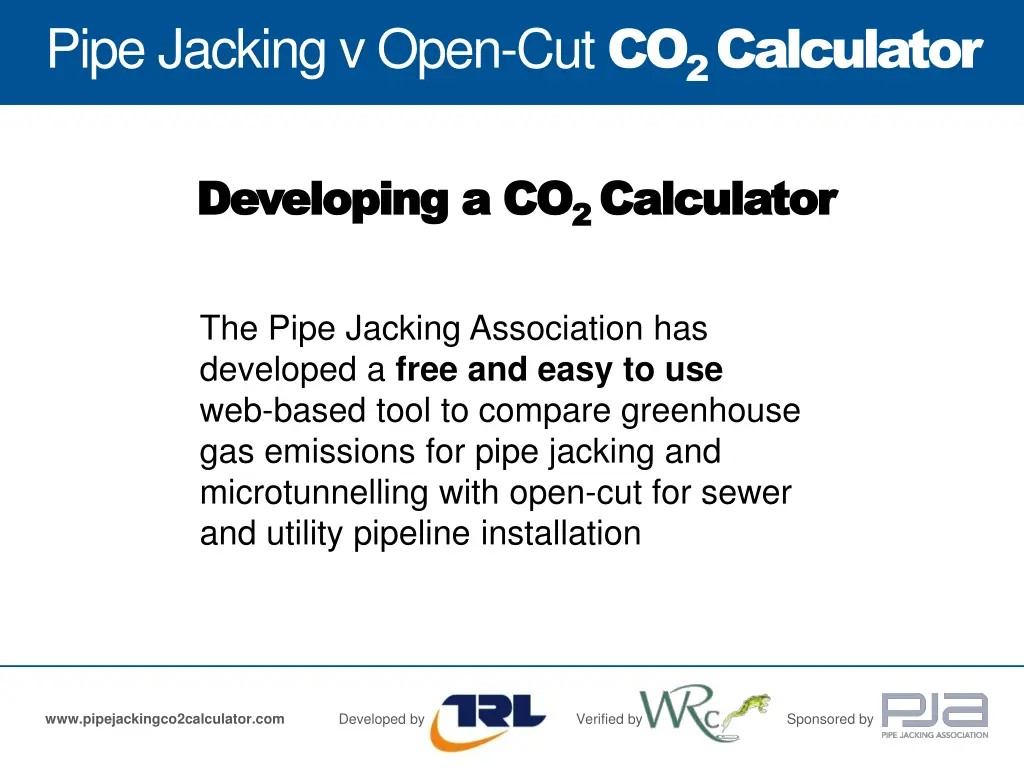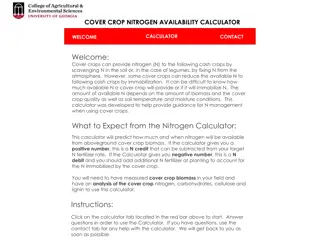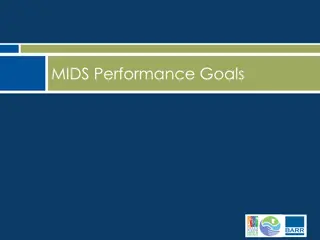
Compare CO2 Emissions: Pipe Jacking vs. Open-Cut Calculator
The Pipe Jacking Association offers a user-friendly web tool to compare greenhouse gas emissions for pipe jacking and microtunnelling with open-cut methods for sewer and utility pipeline installations. This initiative is essential in the context of the UK government's commitment to reducing emissions and improving energy efficiency by 2050. By utilizing this calculator, utilities can fulfill their obligations to cut emissions and demonstrate corporate sustainability, ultimately promoting environmentally friendly practices in utility installations.
Download Presentation

Please find below an Image/Link to download the presentation.
The content on the website is provided AS IS for your information and personal use only. It may not be sold, licensed, or shared on other websites without obtaining consent from the author. If you encounter any issues during the download, it is possible that the publisher has removed the file from their server.
You are allowed to download the files provided on this website for personal or commercial use, subject to the condition that they are used lawfully. All files are the property of their respective owners.
The content on the website is provided AS IS for your information and personal use only. It may not be sold, licensed, or shared on other websites without obtaining consent from the author.
E N D
Presentation Transcript
Pipe Jacking v Open-Cut CO2 Calculator Pipe Jacking v Open-Cut CO2 Calculator Developing a CO Developing a CO2 2 Calculator Calculator The Pipe Jacking Association has developed a free and easy to use web-based tool to compare greenhouse gas emissions for pipe jacking and microtunnelling with open-cut for sewer and utility pipeline installation www.pipejackingco2calculator.com Developed by Verified by Sponsored by
Pipe Jacking v Open-Cut CO2 Calculator Why develop a carbon calculator for utility installation? The UK Government through the Department of Energy and Climate Change (DECC) is committed to reducing carbon emissions by 80% on 1990 levels by 2050. This ambition is enshrined in UK law with binding targets spanning successive Parliaments Utilities have an obligation to cut emissions and improve energy efficiency under the DECC CRC Energy Efficiency Scheme DEFRA s Key Performance Indicators (KPIs) oblige utilities to demonstrate corporate sustainability Carbon emissions apart, it is accepted that digging up roads for utility installation when there are practical and economic alternatives is socially unacceptable www.pipejackingco2calculator.com Developed by Verified by Sponsored by
Pipe Jacking v Open-Cut CO2 Calculator Background A carbon calculator developed to highlight the reduction potential of trenchless technology had been developed by the British Colombia Chapter of the North American Society of Trenchless Technology in association with the Action on Climate Change Team (ACT) of Simon Fraser University in British Columbia The project was transferred to NYSEARCH, a New York based research group, that works on behalf of North American gas and water utilities and the project put on hold As a result the UK Pipe Jacking Association decided to sponsor the development of a free and easy to use calculator and appointed TRL to carry out the project www.pipejackingco2calculator.com Developed by Verified by Sponsored by
Pipe Jacking v Open-Cut CO2 Calculator Trenchless Open-Cut www.pipejackingco2calculator.com Developed by Verified by Sponsored by
Pipe Jacking v Open-Cut CO2 Calculator Pipe Jacking is an integrated system linking: soils jacking shaft pipes shields jacking loads engineering www.pipejackingco2calculator.com Developed by Verified by Sponsored by
Pipe Jacking v Open-Cut CO2 Calculator Objective To develop a calculator to compare carbon emissions for pipe jacking and microtunnelling with open-cut construction for sewer and utility pipeline installation that was: Easy to use Transparent Comprehensive to include all parameters Authoritative Verified www.pipejackingco2calculator.com Developed by Verified by Sponsored by
Pipe Jacking v Open-Cut CO2 Calculator Input Datasets The PJA prepared a range of datasets covering all pipe jacking and microtunelling and open-cut operations: Comprehensive materials schedule for all pipe diameters from 200 2400mm to include manholes, shafts, base slabs and all other components that impact on carbon emissions Plant schedules for both scenarios together with energy usage Machinery selection for all diameters in differing ground conditions, both wet and dry Project duration realistic outputs and daily hours worked Average haulage distances for plant and materials www.pipejackingco2calculator.com Developed by Verified by Sponsored by
Pipe Jacking v Open-Cut CO2 Calculator Consultant Appointed The PJA appointed TRL to carry out the project. TRL is an internationally recognised centre of excellence providing world-class research, consultancy, testing and certification for all aspects of transport The Association had worked with TRL previously in the production of a report Mitigating the disruption caused by utility roadworks which it is believed had a significant influence in revisions to the New Roads and Streetworks Act and the introduction of Lane Rental www.pipejackingco2calculator.com Developed by Verified by Sponsored by
Pipe Jacking v Open-Cut CO2 Calculator TRL Data Sources and Protocols University of Bath Inventory of Carbon and Energy for construction materials Concrete Pipeline Systems Association Carbon Footprint of pipes, slabs and manholes TRL s QUADRO program (Queues and Delays at Roadworks) PAS 2050: Assessing the Life Cycle Greenhouse Gas Emissions of Goods and Services www.pipejackingco2calculator.com Developed by Verified by Sponsored by
Pipe Jacking v Open-Cut CO2 Calculator A life cycle approach Advocated by PAS 2050 Assesses part of a pipeline s life cycle Raw material extraction to installation Designed to be a comparative tool open cut vs. pipe jacking on a level playing-field Consequential impacts not included Re-instatement following open cut installation can result in significant highway degradation though not assessed at this stage www.pipejackingco2calculator.com Developed by Verified by Sponsored by
Pipe Jacking v Open-Cut CO2 Calculator Materials Transport Installation Traffic Product carbon footprints: Manufactured pipeline components: pipes, manholes, bases & covers Virgin aggregate fill Asphalt Transport emissions: Pipeline components to site Fill and asphalt to site Spoil to disposal Trench support to and from site Machinery fuel consumption: Detailed equipment inventories Duration of operation algorithms Load factors based on soil type Presence of groundwater Emissions from queuing traffic: Lane closures - shuttle working for open cut Dependent on road types and traffic levels QUADRO www.pipejackingco2calculator.com Developed by Verified by Sponsored by
Pipe Jacking v Open-Cut CO2 Calculator FEASIBILITY AS DESIGNED AS BUILT Enter the pipeline depth, length and diameter All other parameters auto-filled Gives a ballpark CO2e estimate More parameters are certain Enter additional info regarding the site location, type of machinery, outputs and working durations Makes the best available prediction Enter retrospective information on all parameters Effectively audits the as designed CO2e figures INCREASING LEVEL OF DATA INPUT PREDICTION EVALUATION INCREASING ACCURACY www.pipejackingco2calculator.com Developed by Verified by Sponsored by
Pipe Jacking v Open-Cut CO2 Calculator Data Verification An independent external source was used to verify the methodology and outputs produced by TRL Verification was carried out by WRc, a research-based consultancy, that utilises scientific and engineering skills to develop robust and sustainable solutions for clients in the water and waste industry. The Calculator has been verified by WRc www.pipejackingco2calculator.com Developed by Verified by Sponsored by
Pipe Jacking v Open-Cut CO2 Calculator WRc Peer Review WRc s audit examined the numerous equations developed by TRL to compare outputs between pipejacking and conventional open-cut trenching These calculations traced the input/output of CO2 for materials, transport, traffic and machinery and equipment WRc also reviewed the data sources and assumptions used in the calculator although it did not review the sources for emission factors used by TRL as these are generally accepted industry standards www.pipejackingco2calculator.com Developed by Verified by Sponsored by
Pipe Jacking v Open-Cut CO2 Calculator Home Page www.pipejackingco2calculator.com Developed by Verified by Sponsored by
Pipe Jacking v Open-Cut CO2 Calculator User Input Screen: Basic parameters At feasibility stage the only inputs required are diameter, length and depth www.pipejackingco2calculator.com Developed by Verified by Sponsored by
Pipe Jacking v Open-Cut CO2 Calculator User Input Screen: Site parameters, machinery, transport and traffic At feasibility these are default values detailed in data sources and assumptions www.pipejackingco2calculator.com Developed by Verified by Sponsored by
Pipe Jacking v Open-Cut CO2 Calculator Report Output Following data input, reports are produced literally in seconds and can either be saved or printed. Reports include: Basic parameters diameter, length, depth, manholes/shafts and road type Site parameters groundwater, construction period and working hours Machinery selection Transport and traffic management options Tonnes of CO2e generated for each of the above and also for traffic delays at the site for open cut scenario Data Sources and Assumptions www.pipejackingco2calculator.com Developed by Verified by Sponsored by
Pipe Jacking v Open-Cut CO2 Calculator Report Output Screen www.pipejackingco2calculator.com Developed by Verified by Sponsored by
Pipe Jacking v Open-Cut CO2 Calculator Examples of CO2 Savings using pipejacking 600mm dia x 500m length x 6m deep 75% saving (Open cut 492.4 tonnes: Pipejacking 124.6 tonnes) 1200mm dia x 500m length x 6m deep 57% saving (Open cut 756.5 tonnes: Pipejacking 328.3 tonnes) 600mm dia x 500m length x 4m deep 67% saving (Open cut 351.4 tonnes: Pipejacking 113.3 tonnes) 1200mm dia x 500m length x 4m deep 47% saving (Open cut 570.6 tonnes: Pipejacking 301.8 tonnes) www.pipejackingco2calculator.com Developed by Verified by Sponsored by
Pipe Jacking v Open-Cut CO2 Calculator Overview Carbon savings only represents one of the benefits offered through the use of trenchless technology with emission savings of up to 75% Pavement life is reduced by up to 30% by open cut construction Lane rental costs for open-cut of up to 2,500 per day are a real cost to the community Roadworks related congestion costs the economy 4bn a year (DfT press release Jan 2012) www.pipejackingco2calculator.com Developed by Verified by Sponsored by
Pipe Jacking v Open-Cut CO2 Calculator Your guarantee of quality and experience www.pipejacking.org www.pipejackingco2calculator.com Developed by Verified by Sponsored by






















